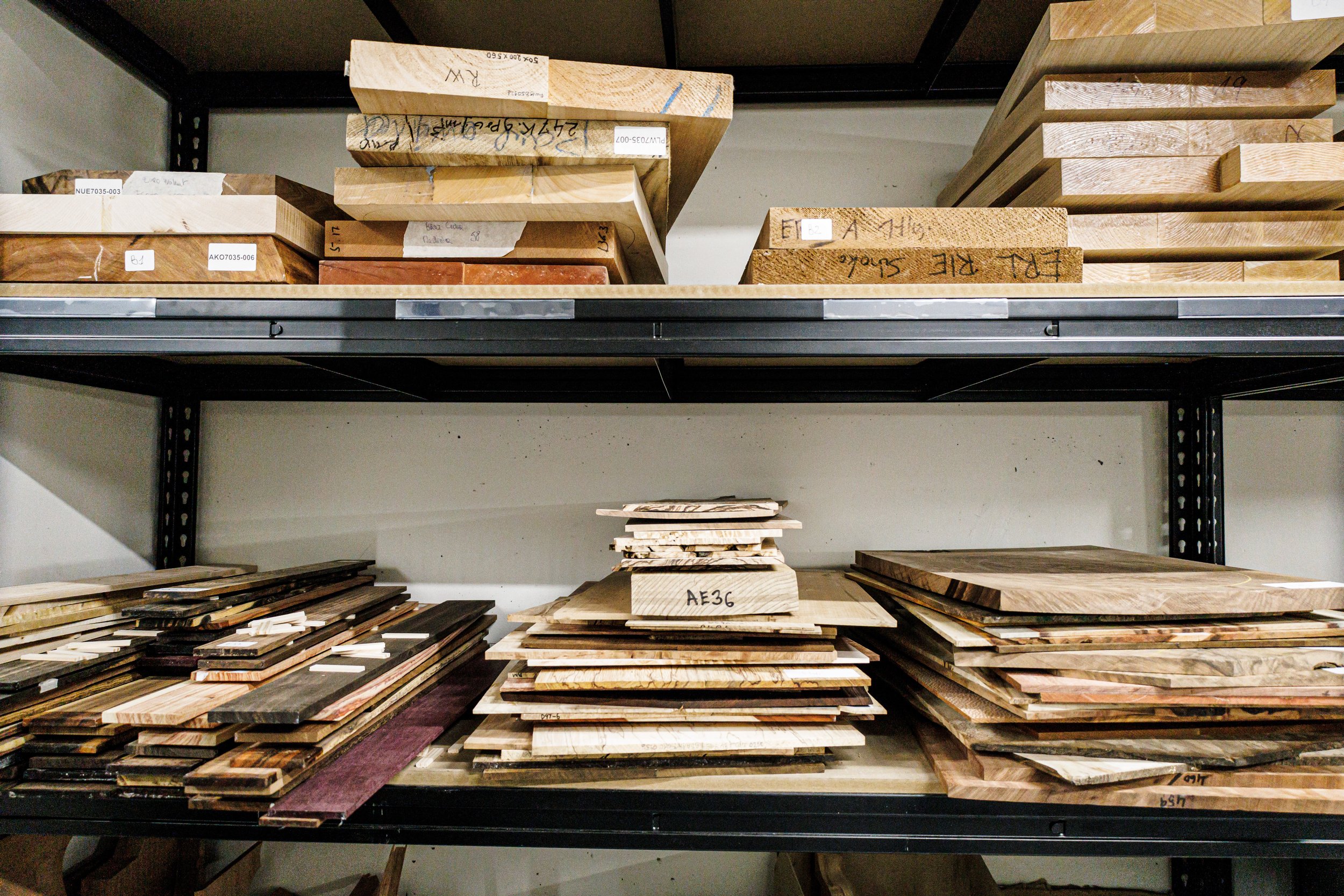(ユニークなコレクション)
ベルフォルティ®ウッドライブラリー
Belforti®ウッドライブラリーを見る
私たちのウッドライブラリーは、利用可能な最新の技術と科学的方法を用いた最先端の評価システムに基づいて設立され、整理されたユニークな木工作品のコレクションです。
ライブラリーは、以下に詳述するいくつかの要素に基づき、3つのカテゴリーに分類されているが、最も重要なのは、さまざまな科学的測定を独自のスコアにまとめたベルフォルティ・レーティング™である。
-
これらの木材は、音質と耐久性に優れたものを厳選しています。トーンバランスに優れ、凹凸が少なく美しい。信頼性の高い高品質な楽器を、お求めやすい価格でお探しのプレイヤーに最適な選択です。
すべてのプレミアム・グレードの木材は、ベルフォルティ・レーティング™で70~79点を獲得している。
-
マスターグレードは、視覚的な魅力と音色の優位性において、ワンランク上の木材です。より顕著な姿と色彩を示し、優れた音色の豊かさと響きを生み出すことが期待されています。プロミュージシャンからアマチュアまで、幅広い層から支持される、完璧な品質と独特の美しさを持つ木材です。
マスターグレードの木材はすべて、ベルフォルティ・レーティング™で80~89点を獲得している。
-
最高品質の木材はプライベート・ストックに分類されます。これらの木材は、カスタムショップやハイエンド・ブティックの楽器にのみ使用されます。これらの木材は通常、並外れた美しさ、希少性、卓越した音色によって区別されます。プライベート・ストック材で作られた楽器は真の芸術品であり、その音楽性だけでなく美的魅力のためにコレクションされることもあります。
すべての未公開株林は、ベルフォルティ・レーティング™で90点以上を獲得している。







Belforti Instruments®では、世界の森林が持つ計り知れない価値と、楽器の製作において森林が果たす役割を理解しています。そのため、私たちは木材の調達方法を可能な限り責任ある倫理的なものにするよう努めています。
原産地、供給、倫理
私たちの森の成り立ち
私たちが厳選したウッドライブラリーには、世界各地から取り寄せたさまざまな種類の高級木材が並んでいます。私たちは、独自の音色、美的魅力、作業特性で知られる樹種を選んでいます。アメリカンマホガニーの豊かな響き、アフリカンエボニーの鮮やかな音色、ミシガンメイプルの印象的な美しさなど、あらゆる音楽的要件と個人の美的嗜好に応えるコレクションを揃えています。
私たちの生産は非常に少量であるため、信頼できる持続可能な供給源から得られるものであれば、外来種の使用も許可しています。私たちのエッセンスの大部分は、私たちが愛するフランスのジュラやヴォージュの森から、主に地元で調達されています。
エシカルサプライ
私たちの倫理的な調達へのコミットメントは揺るぎないものです。私たちは、最高の環境基準を守り、世界の森林に対する尊敬の念を共有するサプライヤーと緊密に連携しています。私たちが使用する木材は、絶滅のおそれのある野生動植物の種の国際取引に関する条約(CITES)やレイシー法などの国際的な法律や規制を遵守し、合法的に調達されたものです。
恩返し
私たちの自然界への畏敬の念は、木材の調達にとどまりません。私たちは、環境への還元を信じ、森林再生活動に貢献しています。私たちの目的は、美しい音楽の創造が、地球の健康を犠牲にするものではないことを保証することです。
ベルフォルティーの楽器を選ぶことは、比類ない品質とクラフトマンシップを持つ楽器に投資するだけでなく、倫理的で持続可能な活動を重視するビジネスを支援することでもあるのです。私たちは共に、自然の調和と共鳴する音楽を創造していきましょう。
サステイナビリティ
Belforti Instrumentsでは、持続可能性を優先しています。私たちは、世界の森林を将来の世代のために保護する役割を認識しています。そのため、私たちのショップでは、適切に管理された持続可能な森林や家族による搾取で採取された木材のみを使用しています。
私たちの哲学は、私が住んでいて深く愛しているマダガスカルのように、多くの場合、小さな家族経営の搾取事業者が環境を保護し、地元の資源で自分たちの未来を確保しようと奮闘しているというものです。一方、その隣には、持続可能な収穫のための保護ガイドラインを尊重しない、疑わしい搾取がしばしば存在します。国や種族全体をボイコットすることは、確かに問題の一部を解決することになりますが、ビジネスが破綻した場合に密猟や闇取引に走る可能性のある地域社会の健全な発展を損なうことになるのではないでしょうか。
その代わりに、私たちは世界中の小規模生産者、家族経営、または協同組合事業者と緊密に連携しています。そうすることで、私たちは業界の積極的な活動家を支援し、地域社会に、資源を収穫する適切な方法が経済的にも倫理的にもより実行可能であることを示すことができるのです。
さらに、木材を余すところなく活用することで、製造工程での無駄を省くことにも努めています。
保存、乾燥、エージング工程
Belforti楽器では、適切に熟成され保存された木材が、優れた楽器の製作に重要な役割を果たすことを理解しています。私たちの品質と職人技へのこだわりは、トーンウッドの準備に細心の注意と忍耐を払うことにまで及んでいます。
-
私たちのトーンウッドの旅は、保存から始まります。木が切り出されるとすぐに、反りや割れの原因となる水分の急激な減少を防ぐための措置が取られます。そのため、木口をワックスなどで密閉し、乾燥のプロセスを調整することもあります。木が本来持っている美しさや響きを損なわないように、木そのものを大切に保存していくのです。
すべてのプレミアム・グレードの木材は、ベルフォルティ・レーティング™で70~79点を獲得している。
-
適切に保存された木材は、乾燥の段階に入ります。この段階では、自然乾燥と窯変乾燥のバランスを微妙に取りながら、水分を減らしていきます。空気乾燥は、含水率を下げる最も穏やかな方法で、数カ月から数年間続くこともあります。キルン乾燥は、厳しく管理された条件下で行われ、残存する余分な水分を根絶するために行われます。この二重の乾燥プロセスにより、楽器が生涯に渡って経験する典型的な状態に近い含水率を達成することができるのです。
マスターグレードの木材はすべて、ベルフォルティ・レーティング™で80~89点を獲得している。
-
木材の準備工程の最終段階は、エイジングです。木材が古くなると、その音色が変化し、より豊かで響きのある音になることがあります。この間、木材はゆっくりと調整され、安定するように管理された状態で慎重に保管されます。木材に含まれる樹脂が硬化し、楽器がより反応しやすくなり、音色がより複雑になるのです。
Belforti Instruments®では、時間がトーンウッドに与える大きな影響を信じています。一本一本の木材を準備するために投資した年月は、私たちの楽器のユニークな音色と卓越した品質に反映されています。
すべての未公開株林は、ベルフォルティ・レーティング™で90点以上を獲得している。






ベルフォーチの評価
Objective Tonewood Performance Analysis
Introduction - Bridging Scientific Measurement and Instrument Construction
The Belforti Rating System represents a groundbreaking approach to tonewood analysis, emerging from the critical need to transform instrument construction from an art of intuition to a science of precision. Inspired by Bryan Galloup's pioneering wood rating system for acoustic guitars, this methodology extends scientific material assessment to electric guitar construction.
Foundational Principles
Objective Material Characterization
Exclusive focus on measurable, quantifiable material properties
Elimination of subjective perception in material selection
Systematic approach to understanding wood's fundamental physical behaviors
Scientific Measurement Framework The system draws from multiple interdisciplinary research domains:
Materials Science
Acoustic Engineering
Vibration Analysis
Non-destructive Testing Methodologies
Comprehensive Analytical Parameters
1. BING (Beam Identification by Non-destructive Grading)
Developed by CIRAD Research Center, BING represents a breakthrough in material assessment. This vibration analysis technique provides critical insights into wood's mechanical properties through non-invasive testing.
Key Measurements:
Elasticity Modulus
Internal Friction Characteristics
Vibrational Response Patterns
Relevant Research:
Bucur, V. (2006). Acoustics of Wood. Springer Series in Wood Science.
Brémaud, I. (2012). Characterization of Wood Acoustical Properties. Journal of Non-Destructive Evaluation.
2. Detailed Material Property Analysis
2.1 Density Measurement
Methodology: Mass per unit volume determination
Significance: Directly impacts energy transfer, sustain, and vibrational characteristics
Measurement Technique: Hydrostatic weighing and volumetric displacement
2.2 Janka Hardness
Definition: Wood's resistance to wear and indentation
Testing Method: Steel ball indentation force measurement
Implications: Determines material durability and structural integrity
2.3 Modulus of Elasticity (Young's Modulus)
Quantification: Material's stiffness under applied force
Calculation: Stress-strain relationship analysis
Relevance: Predicts wood's flexural and vibrational potential
2.4 Modulus of Rupture
Measurement: Maximum stress before structural failure
Significance: Determines material's bending strength and structural limits
3. Advanced Analytical Techniques
3.1 FFT (Fast Fourier Transform) Analysis
Purpose: Transform vibrational signals between time and frequency domains
Outcome: Detailed spectral characteristic mapping
Applications:
Resonance potential identification
Vibrational energy transfer analysis
3.2 First Mode Frequency Determination
Definition: Primary resonant frequency of material sample
Measurement: Controlled excitation and frequency response analysis
Significance: Fundamental vibration characteristic indicator
4. Quantified Sustain Potential (QSP)
Innovative Composite Measurement
The QSP represents a breakthrough in material performance assessment, establishing a nuanced relationship between density and Quality Factor (Q-factor).
Key Characteristics:
Prioritizes density as primary performance indicator
Contextualizes Q-factor within density framework
Provides comprehensive material performance index
Calculation Methodology:
Measure raw density
Analyze Q-factor
Apply weighted algorithmic assessment
Generate composite performance score
Comparative Analysis:
High Q-factor in low-density wood: Limited performance potential
Average Q-factor in high-density wood: Superior performance characteristics
5. Rating System Mechanics
Scoring Methodology
Comprehensive rating on 100-point scale
Threshold for critical component usage: 70 points and above
Sub-70 point materials: Repurposed for secondary components
Tested Component Scope
Guitar bodies
Necks
Fretboards
6. Production Consistency Approach
System Capabilities
Material property retroengineering
Systematic wood grading
Comprehensive performance database development
Reproducible material characteristic mapping
Technological Foundations
Inspirational Sources:
Bryan Galloup's Acoustic Wood Rating System
CIRAD Research Center's Non-Destructive Testing Protocols
Advanced Materials Science Research
Comparative Research References
Brémaud, I. (2012). "Wood Acoustics and InstrumentMaking". Wood Science and Technology, 46(1-3), 1-24.
Bucur, V. (2006). Acoustics of Wood. Springer Series in Wood Science.
Wegst, U.G.K. (2006). "Wood for Sound". American Journal of Botany, 93(10), 1439-1448.
結論
Transforming Craftsmanship through Science
The Belforti Rating System represents more than a measurement technique—it's a paradigm shift in understanding material performance. By replacing intuition with precise, reproducible scientific methodology, we challenge traditional approaches to instrument construction.
Future Developments
Expanded material database
Machine learning integration for predictive modeling
Enhanced multi-parameter analysis techniques
Note: This system is a continuous evolution, representing our commitment to scientific precision in instrument manufacturing.


